When most people think of the word “bonsai”, they are thinking of indoor bonsai trees. However, there are many types of bonsai, both indoors and out. This low-maintenance plant is popular for many reasons. Bonsai is an ancient Japanese art form that involves the practice of growing miniature trees in containers. When we say, “indoor bonsai”, we are specifically referring to those that are cultivated for an indoor environment. Let’s explore more.
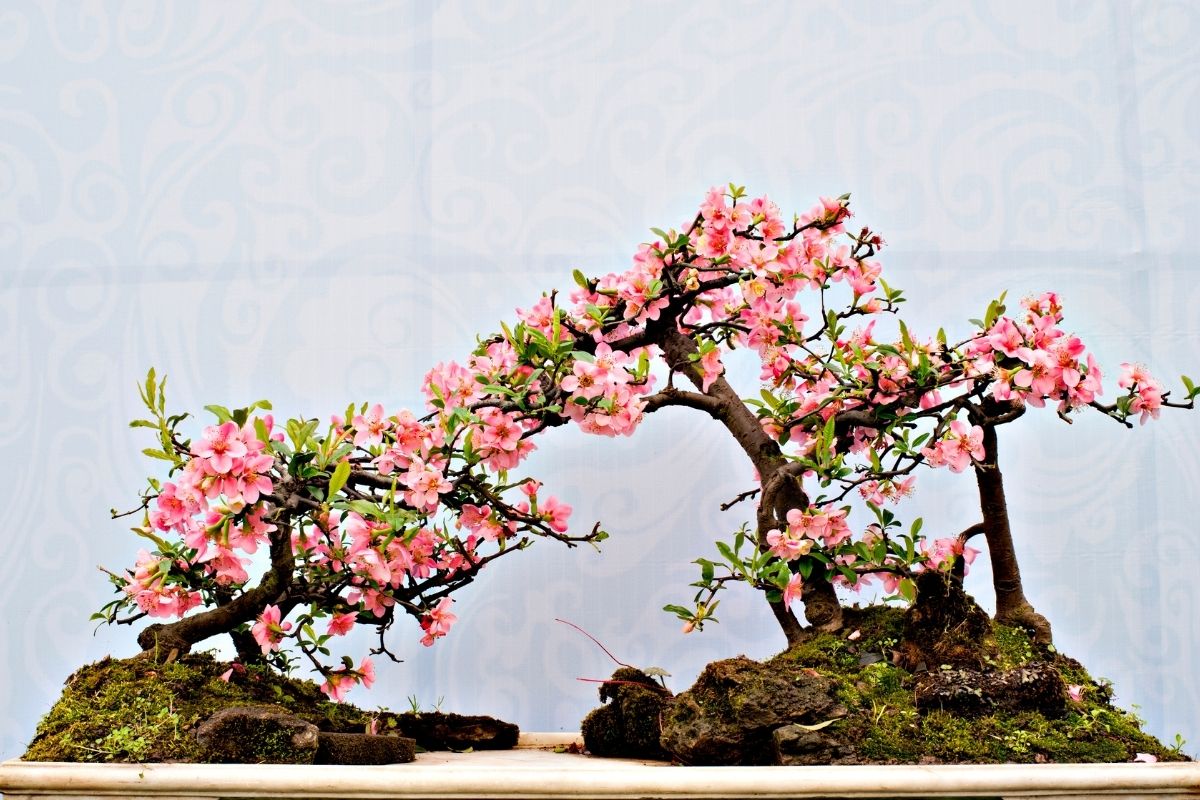
Types of Indoor Bonsai
There are so many great indoor bonsai, such as the Japanese maple, the Fukien tea tree, Japanese white pine, jade trees, ficus bonsai tree, tropical bonsai trees, Chinese Elm bonsai tree and so many more. No matter which bonsai species you choose, the
These bonsai are suitable for an indoor environment, but they can also be placed outdoors if the climate is right. Some people like to move them indoors and out, as the seasons change. If you’re looking for low-maintenance indoor plants, then bonsai may be just what you’re looking for. Here are some types of indoor bonsai you might consider.
1. Ficus
Ficus is a wonderful tree for bonsai. There are many varieties, including smaller ones that are great for indoor bonsai. Ficus trees are a very popular plant used for bonsai because of their shape, their ease of care, and their attractive leaves.
The species of ficus plays a role in what it looks like and how your tree will grow. Ficus retusa, for example, is an excellent indoor tree that is perfect for bonsai. This species of evergreen is woody and has unique trees and leaves that work very well for beautiful bonsai.
2. Chinese elm
The Chinese elm is another very popular bonsai tree. It comes in a lot of varieties, which include the Chinese elm, Grand Chinese elm, large Chinese elm, showcase Chinese elm, Shohin Chinese elm, and the miniature Chinese elm.
3. Dwarf jade
Another great plant for indoor bonsai is the dwarf jade. Smaller than its regular variety, it’s perfect for keeping in small pots and shaping for bonsai. Jade plant is good with sandy loam, and it requires very good drainage. It can be trimmed up and shaped.
4. Weeping fig
You might also consider weeping fig, which is known scientifically as Ficus benjamina. It’s native to India and Malaysia but it’s now found all over the world in homes and offices as a bonsai. The canopy has interesting branches and shiny, oval leaves.
5. Japanese flowering cherry
And another option is the Japanese flowering cherry. In full bloom, this plant is so beautiful. However, it is a bit more high maintenance than some other varieties. It’s also known as the Japanese cherry blossom bonsai.
6. Boxwood
Boxwoods make great trees for bonsai. Buxus is originally from Europe and has dense branches that are often used in outdoor hedges. This small version is perfect for bonsai and it’s great for those who like shaping the leaves.
7. Flowering tea tree
Flowering tea tree is another choice that is perfect for bonsai. It is also known as the Fujian tea tree or the Fukien tree. It has a leaf and trunk structure that is similar to Chinese elm. It has small, dark-green leaves that are round and shiny. It also has small flowers than can bloom year-round, usually white in color.
Some indoor bonsai have small white flowers, some have pink flowers, and some don’t flower at all. Some have rounded leaves and others have pointy leaves. These tiny trees look just like big versions of the same and any of them would make a good choice for your bonsai. The next important thing to know is how to care for your bonsai.
Care of Indoor Bonsai Trees
Now that you know about some great indoor bonsai trees, it’s important to know how to care for them properly. Bonsai can live for hundreds of years (this Chinese elm is 67 years old and up for grabs), but to get the best from them, you need to give them the best care.
They typically come in a small container, which makes it easier to place them wherever you want in your home. Sometimes they come in special or ornamental pots, or you can choose to place them in a fancy pot after you purchase them.
You will also want to invest in a humidity tray. Bonsai do well with high humidity so if you don’t have this, you may need to mist them often. Let’s look at some other important details about the care of indoor bonsai.
Lighting
What kind of lighting will you need for your indoor bonsai? When you have an outdoor plant, the lighting will depend mostly on the sun and shade you have in your yard. But for an indoor plant, you have control over the lighting. Typically, they do best with indirect sunlight. Some people also use artificial light to simulate sunlight when there is none.
Watering
It’s important that your bonsai has very good drainage. Most species benefit from frequent watering, but not saturation, and it’s important that the excess water can drain out and not pool around the roots. This can cause root rot and your plant can die.
It’s important not to use too much water.
Some species prefer low humidity and others need higher humidity. It’s difficult to give enough water when needed but don’t water just for the sake of watering. It’s a good idea to check your tree’s soil. If it feels dry on the top layer, you can water it again. How much hydration they need varies according to the species of tree. Some need watering daily, whereas others can go weeks in between.
Temperature
What is the most ideal temperature for your indoor bonsai? In general, warmer is better. But again, it depends on the species. Most species don’t do well with temperatures that drop below 50. You should also be cautious of putting your plant near a window, an AC vent, or any other draft.
Maintenance
You can look for new growth regularly and then trim where needed to help your tree maintain the shape you desire. Maintenance for bonsai typically involves two parts:
- Structural – This can include wiring of branches and also support keeping the bonsai in place.
- Pruning – Maintenance pruning is an ongoing process that helps shape your bonsai.
Where to Put Your Bonsai
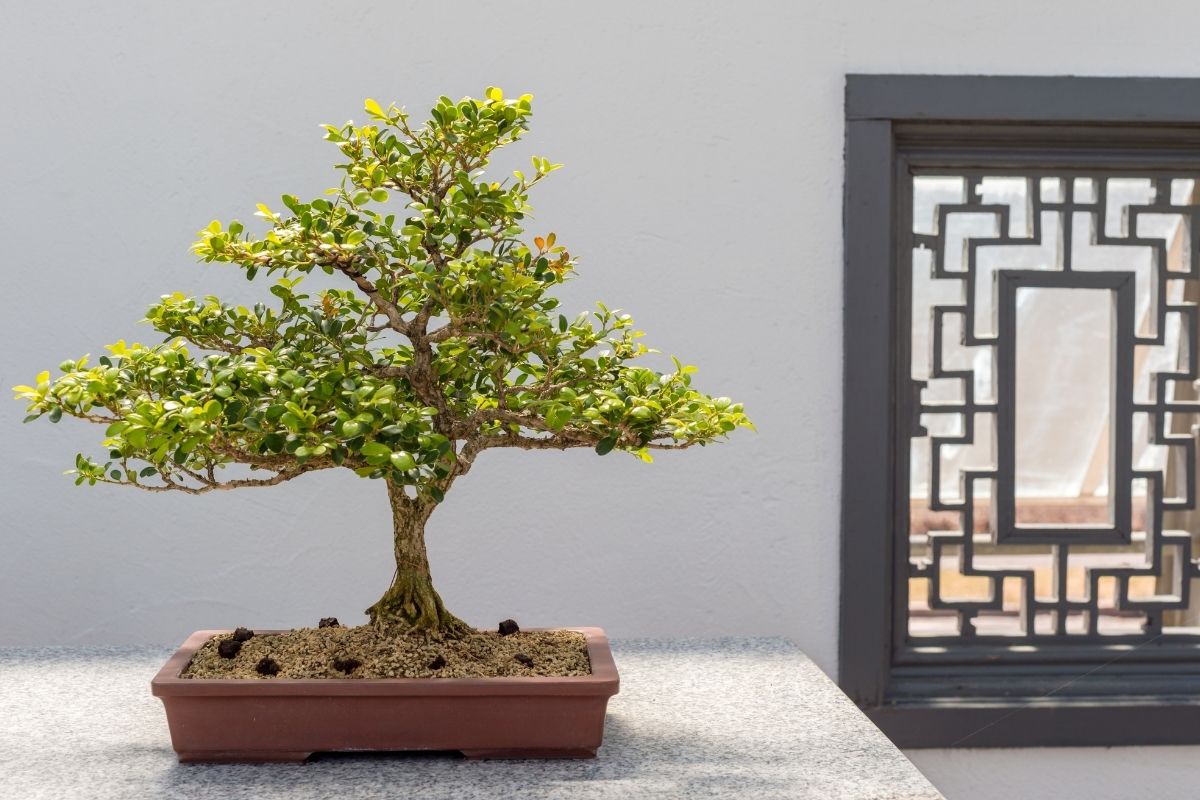
Do you know how to choose the best location for your indoor bonsai? One of the best parts of bonsai is that you can put them just about anywhere. On a shelf, on a desk, in a kitchen on the counter or table, or just about anywhere you want.
Be careful of drafts, AC units, vents, or windows and doors. With the proper care, your bonsai can last for a very long time.
Indoor vs Outdoor Bonsai
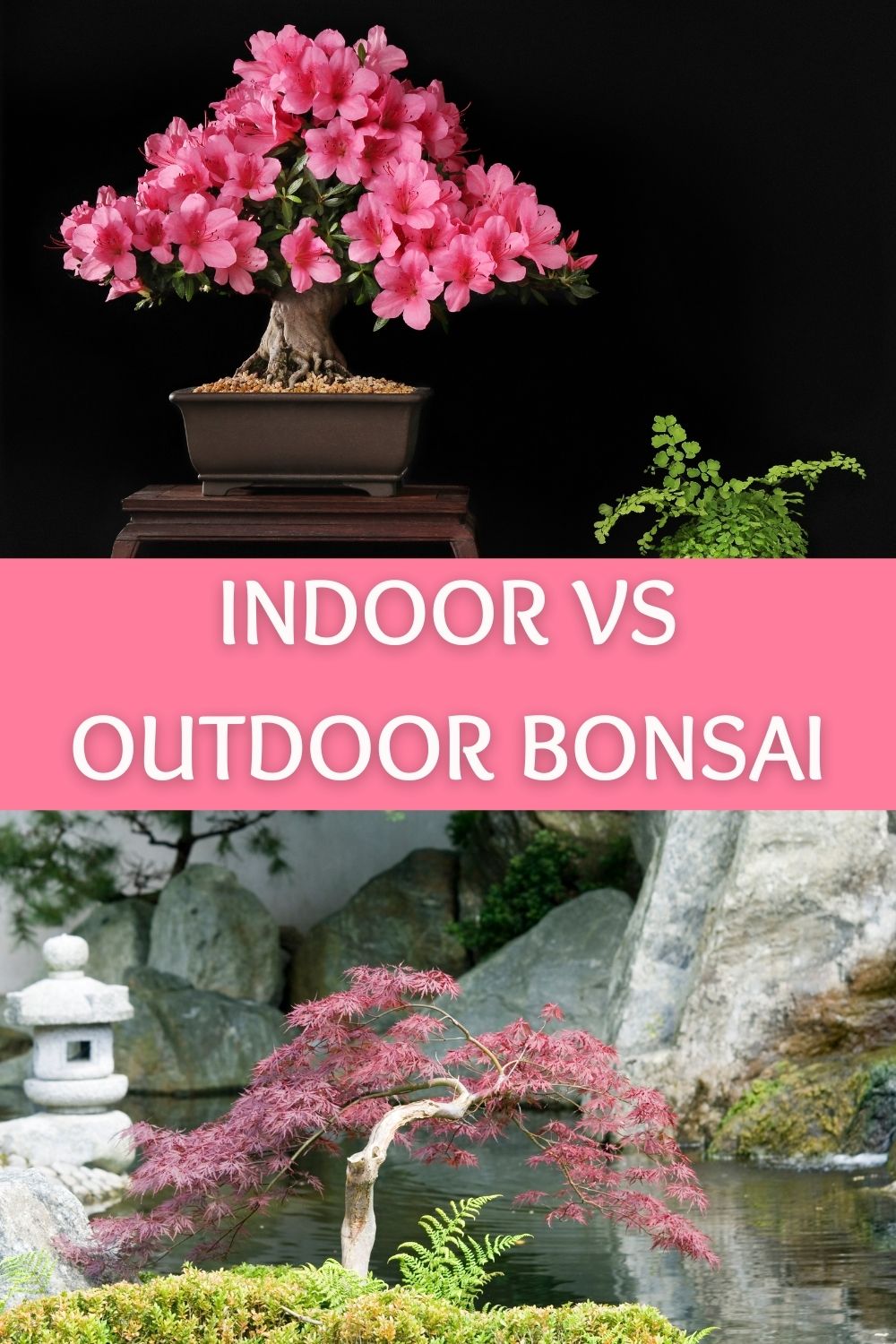
What is the difference between indoor and outdoor bonsai? It’s not just a simple matter of keeping one indoors and the other outdoors. The varieties that grow outside are bigger and they typically require a different climate.
Indoor bonsai are often miniature versions of the ones that grow outdoors, but other times they are a completely different species of tree. Some people keep bonsai outside in warmer weather and then bring it inside during the winter months.
Of the many different species of plants that are used in bonsai, they have many different growing conditions. Some must be grown indoors, where some must be grown outdoors, and some can be grown either.
Varieties that do well indoors include:
- ficus (ficus retusa)
- azalea (azalea indica ‘formosa’)
- aralia
- Norfolk pine (araucaria heterophila)
- gardenia (gardenia jasminoides)
- and more
These are woody-stemmed plants that can do well when you wire their branches to help guide their growth. Tropical and subtropical varieties can die off at temperatures below 40-50 degrees.
Outdoor bonsai trees can survive the winter dormant period. In northern climates, it will be important that you protect your plants from freezing and drying out. But putting them in a heated area can also be dangerous. Use an unheated garage, shed, or another facility, if possible.
What is Bonsai?
The word “bonsai” means “plant in container or vessel” in Japanese. These plants were first grown and cultivated in Japan and over thousands of years, the cultural horticulture practice has grown and spread to other countries across the world.
Bonsai refers to the plant (actually a deciduous tree) as well as the act of tending to bonsai plants. They are small and fit in nearly any space. They can live for many years and provide peaceful entertainment. Traditionally, bonsai are grown outdoors in containers in temperate climates.
There are many different species of plants that can be bonsai, but they don’t all have the same growing conditions. Some are best when grown outdoors, and others do best indoors (learn more about caring for outdoor bonsai trees). Some need more sun, and some can burn if they have too much.
Your own geographic location and climate can also play a role in the type of bonsai that does best for you. What are some reasons you might want to consider indoor bonsai for your own home?
Benefits of bonsai
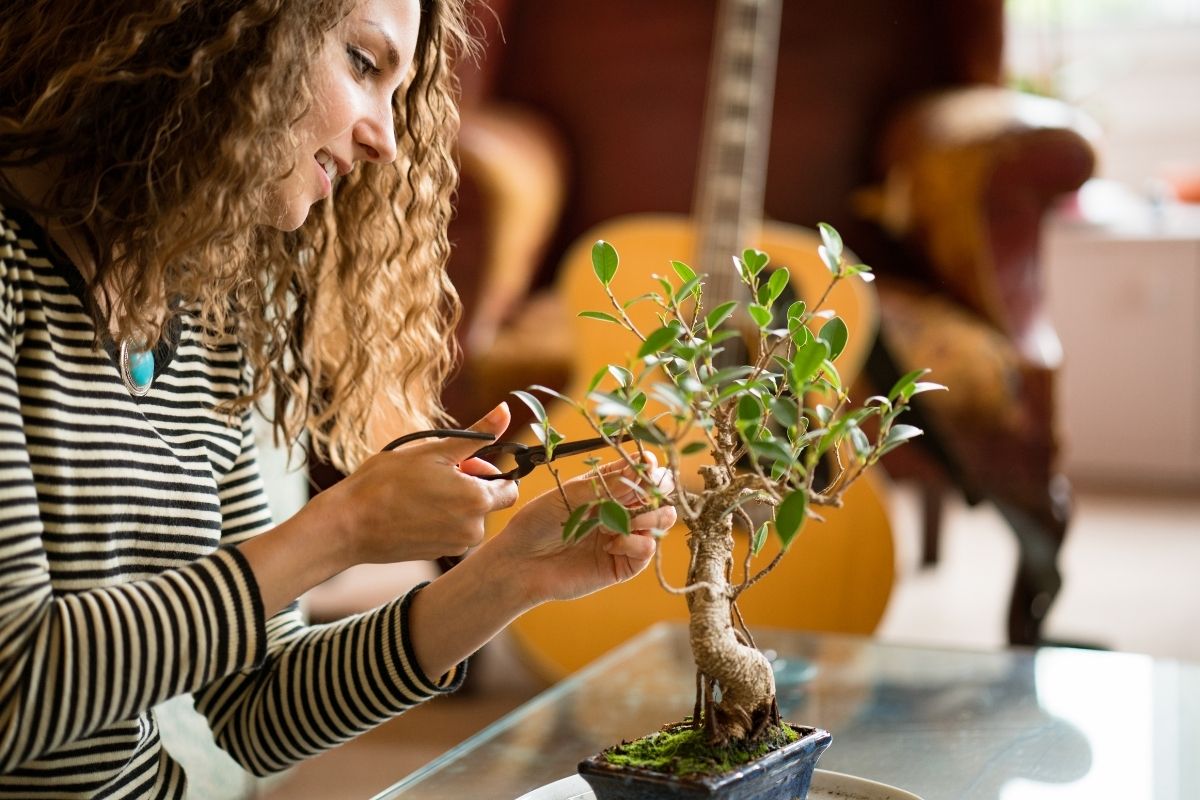
Why do people enjoy bonsai so much? There are many reasons to enjoy bonsai as a hobby. It’s a great way to pass the time and it can be very relaxing and soothing. They are also very easy to care for and many people believe they bring positive energy to a space.
Bonsai trees, like other plants, help bring oxygen to your home, purify the air in the home, and they can also bring many health benefits. Unlike other types of gardening that create a healthy, beautiful environment inside and out, with bonsai, you need to provide full-time care. Watering, fertilizing, and even pruning, are all essential to your bonsai’s health and appearance.
Even a bonsai beginner can learn to take care of this indoor tree and benefit from all that it has to offer. It’s easy to see why so many people turn to it.
It can help improve cognitive function, and mood, and reduce stress. They can help keep you physically active while also improving your patience. You can’t rush with bonsai. You need to take your time to tend to the intricate details.
Final Thoughts on Indoor Bonsai Trees
Now that you have all this great info about indoor bonsai trees, you’re ready to get started. If you don’t already have an indoor bonsai, you can choose one of these from the list to get started. All of these bonsai have easy maintenance, and they are beautiful to look at.
But the personal and emotional benefits from keeping bonsai take some time to develop. They come from the days, weeks, months, and even years of bonding between you and your tree. As you continue to cultivate your bonsai, you will continue to reap the benefits for a long time to come.
The good news is that with proper care, your bonsai will stay with you for a long time to come. It’s the perfect companion plant, even if you have limited space.
Which indoor bonsai do you think you want to care for?

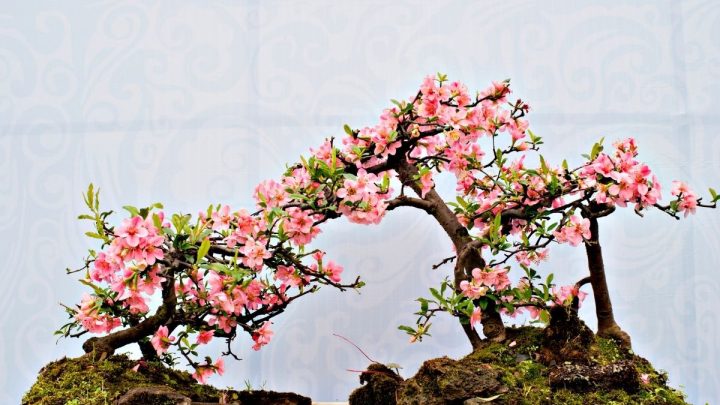








The Best Bonsai Starter Kits For Beginners
Wednesday 4th of January 2023
[…] bonsai projects are just miniature versions of a larger tree that would grow outdoors. When you grow your tree indoors in smaller pots, you can shape and mold the tree and its branches as it grows, to make it look how […]
The Perfect Bonsai Accessories For Your Bonsai Tree
Tuesday 3rd of January 2023
[…] New to bonsai growing? Check out these bonsai starter kits for beginners. And see my 7 top picks for indoor bonsais. […]
How To Grow And Care For Juniper Bonsai Trees
Tuesday 3rd of January 2023
[…] most popular bonsai trees on the market, junipers can be kept indoors or outdoors (learn more about indoor bonsai trees). They are found in many countries all over the globe and there are more than fifty different […]
Flowering Bonsai Trees: The Perfect Addition To Your Home Or Garden
Tuesday 3rd of January 2023
[…] Indoor bonsai plants are a popular hobby all over the globe now, despite originating in Japan. If you want a bonsai tree species that produces flowers, there are many to choose from. They make excellent choices for warm climates, but when keeping indoors, you can have them pretty much anywhere in the world. […]
Guide To Growing Outdoor Bonsai Trees
Tuesday 3rd of January 2023
[…] outdoor bonsai will need the same type of care as indoor bonsai varieties. You’ll need to manage water and lighting, as well as prune and keep the soil healthy. You […]